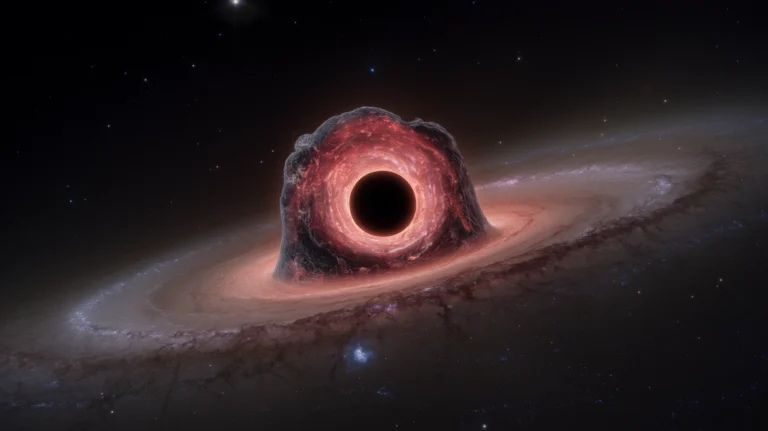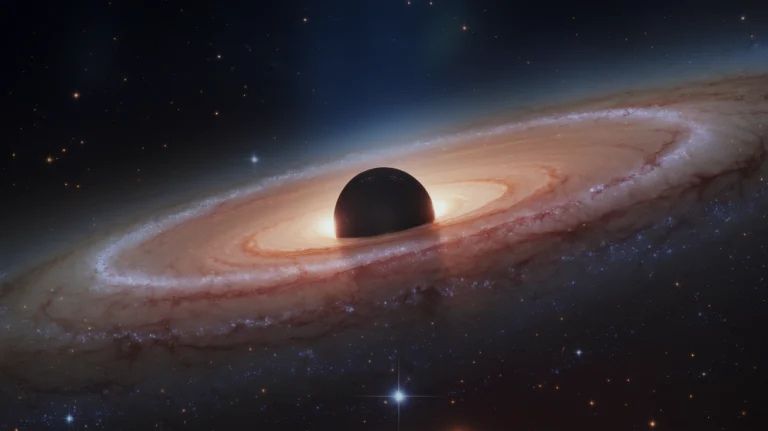Black holes are an enigma that has puzzled scientists and captivated our imagination for decades. But what’s hiding inside a black hole? Is it a void, a bottomless pit, or even a parallel universe? We don’t know for sure yet, but scientists might have some ideas, so let’s hear them out.
Birth of a Black Hole: An Explosive Transformation
Picture this: in the vastness of space, there’s a supermassive star shining bright like a diamond. But, like all good things, this star’s party can’t last forever. Eventually, it runs out of fuel and goes out with a bang—quite literally. The star collapses under its own gravity, creating an implosion. Now, this collapse is so intense that it creates a bottomless pit in space, like a sinkhole. This is what we call a black hole—the ultimate No Escape Zone, sucking up everything in its vicinity, including light.

What Happens as You Approach a Black Hole?
Imagine yourself approaching a black hole. The black hole itself doesn’t emit any light, but you can notice a dazzling display of cosmic fireworks surrounding it—the accretion disc. It’s like a celestial carousel of gas and dust swirling in a mesmerizing dance around the black hole. The incredible gravitational forces pull all this material from their surroundings, creating this celestial furnace.
Of course, it’s very unlikely that you would have survived in this place. Temperatures here soar to millions of degrees, and it constantly dazzles with X-rays and high-energy radiation detectable by telescopes on Earth. But let’s imagine you did survive somehow.
The Event Horizon: A Point of No Return
As you get closer, you notice a mysterious boundary looming ahead: the Event Horizon. It’s a point of no return beyond which the laws of physics seem to go haywire. Now you’re stuck in a space traffic jam, and no matter how hard you hit the gas, you’re going nowhere. Once you cross this threshold, not even light can escape.
Einstein’s Theory and the Distortion of Space Time
Now you inevitably fall into the black hole. What do you see around you? According to the genius physicist Albert Einstein, space and time aren’t separate entities but rather intertwined in a fabric called Space Time. It’s like a cosmic trampoline that can stretch and bend if you place something heavy on it. Black holes are super heavy, which is why they distort this trampoline in the most extreme way.
A Roller Coaster Through Space Time
So, when you venture close to a black hole, you’re in for a roller-coaster ride. The curvature of Space Time becomes so intense that it’s like a whirlpool pulling everything in, even light itself. Everything around you looks like a space fun house, with distorted colors and rays of light that keep shifting. All this makes you feel like you’re doing the moonwalk on a treadmill.
The curvature of Space Time around a black hole is so extreme that it creates a phenomenon called time dilation. Time near a black hole moves at a different pace than in the rest of the universe. The closer you are to the black hole, the slower time ticks, like a slow-motion effect. And the deeper you fall, the weirder things get—the laws of physics seem to break down before your very eyes.
The Singularity: The Heart of a Black Hole
Suppose you somehow managed to survive all this madness. Where exactly are you falling? What awaits you on the other side? Is there even an “other side”? As you venture deeper into the celestial maelstrom, you reach an elusive and mysterious point called the Singularity. It’s the heart of a black hole, a place where all matter and energy are crushed into a single, unimaginably dense point. Imagine cramming the masses of entire stars into something that is essentially a pinprick.
Now that you’re here, forget about the usual rules of physics. Welcome to a new realm where the known breaks down, and the unknown takes over.

Mind-Bending Theories About Black Hole Interiors
What does this unknown look like? Well, there are a couple of theories:
-
A Gateway to Other Dimensions
What if there are multiple universes hiding within black holes, like nesting dolls? According to this theory, the interior of a black hole could be a portal to a parallel universe with its own set of physical laws and possibilities. This parallel universe could be drastically different from our own world. What a mind-bending idea!
-
Wormholes and Space Subways
Imagine black holes forming a space subway system, connecting different regions of space and time with each other. These theories suggest that the extreme gravitational pull of a black hole could create a wormhole—a tunnel that could transport you to another galaxy or even to the past or future. It’s like finding a secret passage in a video game.
-
Exotic Matter
Some scientists propose that inside a black hole, we might find some exotic matter—some strange matter with weird properties or negative energy density. If that’s the case, this would defy our understanding of the universe
-
White Holes: The Opposite of Black Holes
One of the most mind-bending theories is that a black hole could actually lead to a white hole. Imagine as you fall further, you suddenly find yourself in a blindingly bright space show—you’re in a white hole. This is a fountain that’s spewing out matter, energy, and information into the universe with reckless abandon—the birthplace of new universes.
The Hypothetical Concept of White Holes
While black holes are known for their Event Horizon, white holes have an anti-event horizon. With black holes, everything can enter, and nothing can come out; with white holes, it’s the other way around—they repel everything. White holes are hypothetical objects, and their existence hasn’t yet been proven. But if it turns out that they exist, they could be connected to black holes.
Black holes suck everything in, and white holes should take their matter from somewhere. All this matter and energy coming out of the white hole could potentially form new universes. Together, black holes and white holes could establish a universal cycle of creation—the end of one universe leading to the birth of another.
The Challenge of Studying Black Holes
All these theories are beautiful and fascinating, but here’s the catch: there’s still no concrete evidence of them. Black holes remain one of the biggest mysteries of our world. Unfortunately, studying these mysterious beasts isn’t easy. They’re super elusive, and this is one of the biggest challenges for scientists. Black holes don’t emit light, so they can’t be seen directly. They’re essentially invisible to telescopes that rely on light, making them incredibly difficult to observe.
Recent Discoveries and Advancements
Despite the challenges, space enthusiasts need not worry. The future of research in this field is as promising as ever. We’ve already made incredible discoveries. For example, in 2019, we captured the first-ever direct image of a black hole—the central black hole of the galaxy Messier 87. A few years later, we also took a photo of a black hole in the center of our galaxy, the Milky Way, called Sagittarius A·. All this has opened up new avenues for research.
Gravitational Waves and New Technology
Let’s take gravitational waves, for example. You know how rocks leave ripples after falling into water? Well, gravitational waves are ripples in the fabric of Space Time. They carry clues about the most cataclysmic events in the universe. They’ve allowed us to “listen” to the universe, unveiling previously hidden phenomena and events. All these observations provide us with a new way to study black holes.
We constantly make new advancements in technology. The James Webb Space Telescope will provide us with even more detailed observations and insights into the mysteries of black holes. There’s still so much we don’t know, but that’s the beauty of science.
The Thrill of the Unknown
The thrill of the unknown and the curiosity that drives us to explore the mysteries of the universe will keep us looking into the cosmic abyss on the quest to unlock the secrets of our world.
That’s it for today! So hey, if you pacified your curiosity, Explore more Amazing Facts and stay on the mudassirmirza.online!
